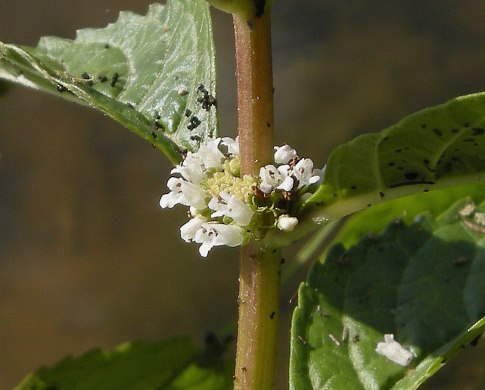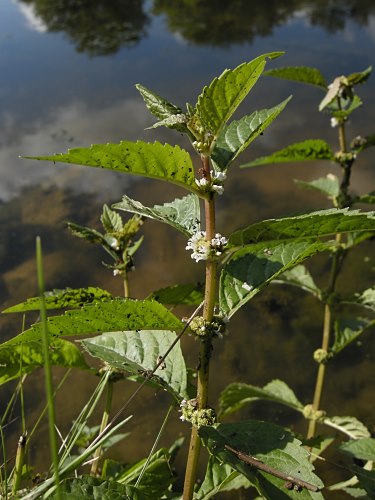Description: This perennial wildflower is 1½–3' tall and more or less erect with an unbranched stem. The stem is light green, 4-angled, and slightly pubescent (covered with short sparse hairs). Along this stem, there are pairs of opposite leaves. Individual leaves are up to 3½" long and 1¾" across; they are medium green, lanceolate-ovate to ovate, and serrated along their margins. Each leaf tapers gradually or abruptly to a short petiole, although some of the upper leaves are nearly sessile. The upper surface of each leaf is hairless, while the lower surface is often slightly pubescent along the central vein. Dense clusters of numerous flowers occur in the axils of the leaves. Each flower is only 1/8" (3 mm.) across, consisting of a light green calyx that is short-tubular with 4-5 teeth, a white corolla that is short-tubular with 4-5 tiny lobes, 2 stamens, and a pistil. The rather broad teeth of the calyx are triangular-ovate. The stamens are more or less included with the corolla. Minute bracts are embedded with the flowers. The blooming period occurs from mid-summer into the fall and lasts about 2-3 months. There is no true terminal inflorescence. Each flower is replaced by 4 small nutlets that are obovoid and flat-topped in shape. The root system is fibrous and stoloniferous, often forming vegetative colonies of plants.

Cultivation:
Virginia
Bugleweed will thrive in full sun to light shade, wet to consistently
moist conditions, and any soil containing significant amounts of
organic matter. Standing water is tolerated for short to intermediate
periods of time.
Range & Habitat:
The native Virginia Bugleweed is found occasionally throughout Illinois
(see Distribution
Map). Within the state, it is less common than Lycopus
americanus (Common Bugleweed), but more common than other Lycopus
spp. Habitats include floodplain woodlands, marshes, borders
of lakes and streams, gravelly seeps, soggy meadows, and ditches. This
species adapts to many kinds of wetlands, whether they are in a
degraded or high quality state.
Faunal Associations:
The flowers attract various bees, wasps, and flies. These insects seek
either nectar or pollen from the flowers as a food source. The
caterpillars of the moth Sphinx eremitus (Hermit
Sphinx) feed on the foliage of Lycopus spp. and
other plants in the Mint family.

Photographic
Location:
Along the border of a lake at Weldon Springs State Park, DeWitt County,
Illinois.
Comments:
Another common name for this species is Virginia Water Horehound. There
are several Lycopus spp. in Illinois, and they are
relatively difficult to distinguish from each other. Virginia Bugleweed
has the following distinct set of features: 1) its leaves are usually
wider and more serrated (with more teeth), 2) the calyx teeth are wider
(triangular-ovate in shape), 3) the stems are slightly pubescent,
rather than glabrous, and 4) the stamens are more or less included
within the corolla, rather than exerted. Other Lycopus spp.
in Illinois differ from Virginia Bugleweed on one or more of these
features. All Lycopus spp. in the state are wetland
plants with small white flowers, and their foliage lacks the strong
fragrance of the various Mentha spp. (Mints).